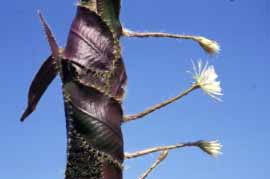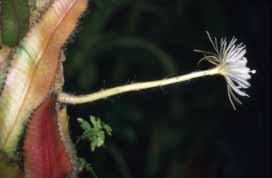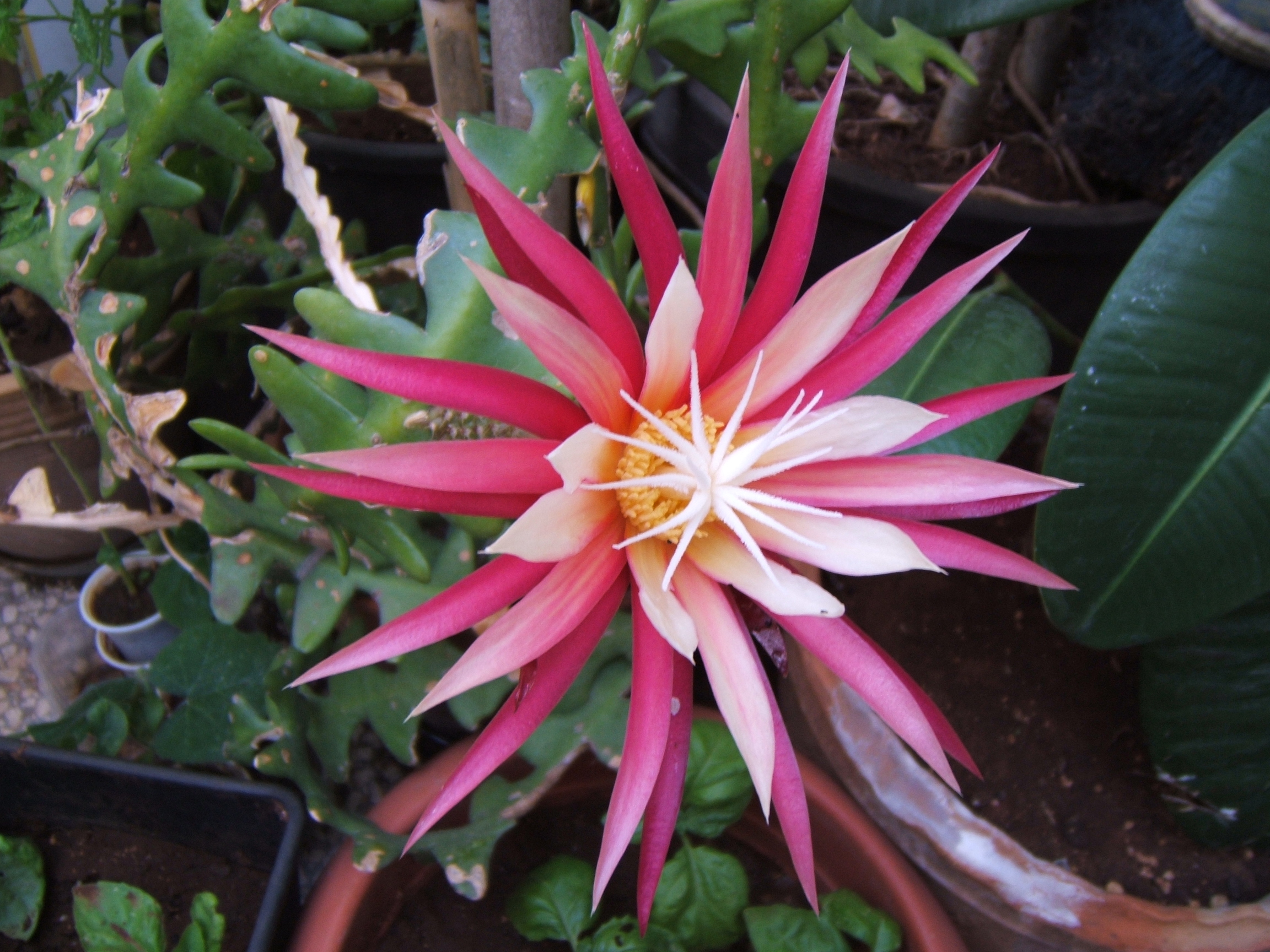|
Strophocactus
''Strophocactus'' is a genus of cacti in the subfamily Cactoideae. Its status and circumscription remain somewhat uncertain, with the genus containing one to three species (not always the same ones). Molecular phylogenetic data suggest that it consists of three species, including two formerly comprising the genus ''Pseudoacanthocereus''. With this circumscription, the species have different growth habits, but share similarities in their flowers, which are white and open at night. Description As circumscribed by Korotkova et al. in 2017, the three species of ''Strophocactus'' have tubular to funnel-shaped flowers with tubercules arranged in ribs and areoles with bristles. The flowers are white and open at night. They are followed by yellow to brown fruits. Two species (''S. brasiliensis'' and ''S. sicariguensis'') are scrambling or decumbent shrubs, with thin stems (up to 4.5 cm across) and tuberous roots. ''S. sicariguensis'' sometimes has flattened stem segmen ... [...More Info...] [...Related Items...] OR: [Wikipedia] [Google] [Baidu] |
Strophocactus Wittii
''Strophocactus wittii'', synonym ''Selenicereus wittii'', known as the Amazon moonflower, is a species of plant in the genus '' Strophocactus'' in the cactus family (Cactaceae), and is one of several species commonly called "moonflowers". It was first described in 1900 and is one of three species of cactus found in the central Amazon basin. It grows epiphytically on the trunks of trees in seasonally flooded forests of the Amazon basin, which is regularly flooded for a few weeks each year. During this time, the seeds spread through the water, which is unique within the cactus family. Description Vegetative characteristics ''Strophocactus wittii'' grows as an epiphyte, creeping and climbing up trees. The richly branched, leaf-like, flattened stems are phylloclades, and are pressed close to the tree trunks of their carriers and form aerial roots along their midrib. When exposed to direct sunlight, the elliptical to lanceolate, dark green shoots turn dull red due to strong b ... [...More Info...] [...Related Items...] OR: [Wikipedia] [Google] [Baidu] |
Strophocactus Wittii 4-93 Foto W
''Strophocactus'' is a genus of cacti in the subfamily Cactoideae. Its status and circumscription remain somewhat uncertain, with the genus containing one to three species (not always the same ones). Molecular phylogenetic data suggest that it consists of three species, including two formerly comprising the genus ''Pseudoacanthocereus''. With this circumscription, the species have different growth habits, but share similarities in their flowers, which are white and open at night. Description As circumscribed by Korotkova et al. in 2017, the three species of ''Strophocactus'' have tubular to funnel-shaped flowers with tubercules arranged in ribs and areoles with bristles. The flowers are white and open at night. They are followed by yellow to brown fruits. Two species (''S. brasiliensis'' and ''S. sicariguensis'') are scrambling or decumbent shrubs, with thin stems (up to 4.5 cm across) and tuberous roots. ''S. sicariguensis'' sometimes has flattened stem segmen ... [...More Info...] [...Related Items...] OR: [Wikipedia] [Google] [Baidu] |
Strophocactus Brasiliensis
''Strophocactus brasiliensis'', synonym ''Pseudoacanthocereus brasiliensis'', is a species of plant in the family Cactaceae. It is endemic to Brazil. Its natural habitats are subtropical or tropical dry forests and hot deserts. It is threatened by habitat loss. Description ''Strophocactus brasiliensis'' grows as a shrub, initially upright and later sprawling. It branches freely. The thin stems are up to across and have 2–7 ribs bearing small areoles with many needle-like spines. The white funnel-shaped flowers are long and across. They open at night. The fruits are yellow when ripe. Taxonomy ''Strophocactus brasiliensis'' was first described, as ''Acanthocereus brasiliensis'', by Britton and Rose in 1920. It was transferred to the genus ''Pseudoacanthocereus'' as ''Pseudoacanthocereus brasiliensis'' by Friedrich Ritter in 1979, a placement still accepted by some sources . A molecular phylogenetic study of the Hylocereeae by Korotkova et al. published in 2017 showed that ''P ... [...More Info...] [...Related Items...] OR: [Wikipedia] [Google] [Baidu] |
Pseudoacanthocereus Brasiliensis (Britton & Rose) F
''Strophocactus brasiliensis'', synonym ''Pseudoacanthocereus brasiliensis'', is a species of plant in the family Cactaceae. It is endemic to Brazil. Its natural habitats are subtropical or tropical dry forests and hot deserts. It is threatened by habitat loss. Description ''Strophocactus brasiliensis'' grows as a shrub, initially upright and later sprawling. It branches freely. The thin stems are up to across and have 2–7 ribs bearing small areoles with many needle-like spines. The white funnel-shaped flowers are long and across. They open at night. The fruits are yellow when ripe. Taxonomy ''Strophocactus brasiliensis'' was first described, as ''Acanthocereus brasiliensis'', by Britton and Rose in 1920. It was transferred to the genus ''Pseudoacanthocereus'' as ''Pseudoacanthocereus brasiliensis'' by Friedrich Ritter in 1979, a placement still accepted by some sources . A molecular phylogenetic study of the Hylocereeae by Korotkova et al. published in 2017 showed that ''P ... [...More Info...] [...Related Items...] OR: [Wikipedia] [Google] [Baidu] |
Strophocactus Sicariguensis
''Strophocactus sicariguensis'', synonym ''Pseudoacanthocereus sicariguensis'', is a species of plant in the family Cactaceae. It is native to Colombia and Venezuela. It has often sprawling thin stems and white funnel-shaped flowers that open at night. Description ''Strophocactus sicariguensis'' grows as a shrub, initially upright and later sprawling. It branches freely from the base. The thin stems are up to long and across and have 2–5 ribs bearing areoles with spines up to long. The white funnel-shaped flowers open at night and are up to long. Taxonomy ''Strophocactus sicariguensis'' was first described, as ''Acanthocereus sicariguensis'', in 1947. It was transferred to the genus ''Pseudoacanthocereus'' as ''Pseudoacanthocereus sicariguensis'' by Nigel P. Taylor in 1992, a placement still accepted by some sources . A molecular phylogenetic study of the Hylocereeae by Korotkova et al. published in 2017 showed that ''Pseudoacanthocereus sicariguensis'' formed a clade with ... [...More Info...] [...Related Items...] OR: [Wikipedia] [Google] [Baidu] |
Echinocereeae
The Echinocereeae are a tribe of cactus, cacti in the subfamily Cactoideae. Since 2006, the tribe has included the former tribe Pachycereeae in many treatments of cactus classification. The exact Circumscription (taxonomy), circumscription of the tribe has been subject to considerable change, particularly since Molecular phylogenetics, molecular phylogenetic approaches have been used in determining classifications, and remains uncertain. The tribe includes large treelike species, such as the saguaro (''Carnegiea gigantea''), as well as shorter shrubby species. Most members of the tribe are found in desert regions, particularly in Mexico and the southwestern United States. Description The tribe includes large treelike species, as well as shorter shrubby species. Some species can grow to be over tall, like the saguaro (''Carnegiea gigantea'') and ''Neobuxbaumia macrocephala''. Their stems are ribbed and columnar, not divided into segments. Most have flowers that open at night. Tax ... [...More Info...] [...Related Items...] OR: [Wikipedia] [Google] [Baidu] |
Hylocereeae
The Hylocereeae are a tribe of cacti. Most are found in the tropical forests of Central and northern South America, and are climbers or epiphytes, unlike most cacti. The tribe includes between six and eight genera in different circumscriptions. The plants known as "epiphyllum hybrids" or "epiphyllums", widely grown for their flowers, are hybrids of species within this tribe, particularly ''Disocactus'', ''Pseudorhipsalis'' and ''Selenicereus'', less often ''Epiphyllum'', in spite of the common name. Description The members of the tribe are very variable in their morphology, especially when the terrestrial ''Acanthocereus'' is included. Many species form aerial roots. The hylocereoid clade (''Selenicereus'', ''Weberocereus'' and probably ''Aporocactus'') are mostly climbing or epiphytic, and have spiny ribbed stems. The phyllocactoid clade (''Epiphyllum'', ''Disocactus'', ''Kimnachia'' and ''Pseudorhipsalis'') are mainly epiphytic, and have spineless flattened leaf-like stems. F ... [...More Info...] [...Related Items...] OR: [Wikipedia] [Google] [Baidu] |
Deamia Testudo
''Deamia testudo'' is a species of flowering plant in the family Cactaceae, native from southern Mexico through Central America to Nicaragua. It was first described in 1838. It is a climber or clamberer, with long stems and large white flowers. Description ''Deamia testudo'' clambers over or hangs from rocks, or climbs or hangs from trees. It produces roots along its stems by which it clings tightly to its support. The stems are made up of segments up to long and in diameter. The stems usually have three ribs, although there may be up to eight. The ribs are thin and wing-like, about high. The areoles have up to 10 or more brownish spines, each long. The flowers have a long thin base and widely spread white tepals. Altogether the flower is about long and across. Taxonomy The species was first described by Joseph Gerhard Zuccarini in 1838, as ''Cereus testudo''. Zuccarini ascribed the scientific name to Wilhelm Friedrich Karwinsky. In 1920, Nathaniel Lord Britton and Josep ... [...More Info...] [...Related Items...] OR: [Wikipedia] [Google] [Baidu] |
Deamia Chontalensis
''Deamia chontalensis'' is a species of flowering plant in the family Cactaceae, native to southwestern Mexico and Guatemala. It has sprawling or pendent branched stems and fragrant white flowers. Description ''Deamia chontalensis'' is either pendent or sprawling, typically growing up to or more long on rocky surfaces and rooting on the underside. The stems are made up of segments long and across. They branch at the nodes between the segments. The stems have 5–6 ribs with slightly sunken areoles bearing yellowish spines long. The very fragrant white flowers are funnel-shaped, long. They are followed by globe-shaped spiny red fruit with a diameter of . Taxonomy The species was first described by Edward Johnston Alexander in 1836, as ''Nyctocereus chontalensis''. It was later placed in the genera ''Selenicereus'' and ''Strophocactus'', but molecular phylogenetic studies in 2017 and 2018 showed that it belonged to a separate clade, and it was transferred to the revived genus ... [...More Info...] [...Related Items...] OR: [Wikipedia] [Google] [Baidu] |
Selenicereus
''Selenicereus'', sometimes known as moonlight cactus, is a genus of epiphytic, lithophytic, and terrestrial cacti, found in Mexico, Central America, the Caribbean and northern South America. The term night-blooming cereus is also sometimes used, but this is also used for many night-blooming cacti, including ''Epiphyllum'' and ''Peniocereus''. In 2017, the genus ''Hylocereus'' was brought into synonymy with ''Selenicereus''. A number of species of ''Selenicereus'' produce fruit that is eaten. The fruit, known as ''pitaya'' or ''pitahaya'' in Spanish or as dragon fruit, may be collected from the wild or the plants may be cultivated. Description Clambering plants with flat to angled stems, producing aerial roots. Areoles may be with or without spines. Flowers are large and nocturnal, pollinated by moths or rarely bats. The receptacle bears small bracts, hairs and usually spines. Fruits bear numerous spines. Flowers are generally produced in abundance with mature plants and are t ... [...More Info...] [...Related Items...] OR: [Wikipedia] [Google] [Baidu] |
Cactoideae
The Cactoideae are the largest subfamily of the cactus family, Cactaceae. Around 80% of cactus species belong to this subfamily. , the internal classification of the family Cactaceae remained uncertain and subject to change. A classification incorporating many of the insights from the molecular studies was produced by Nyffeler and Eggli in 2010. Various revisions have been published since, e.g. to the tribe Hylocereeae and the tribe Echinocereeae. Classifications remained uncertain . Tribes and genera , the National Center for Biotechnology Information used the division of the subfamily into tribes shown below. Some revisions to the circumscriptions of the tribes are also shown. *Blossfeldieae **''Blossfeldia'' * Browningieae **''Armatocereus'' – ''Browningia'' – ''Neoraimondia'' – '' Stetsonia'' *Cacteae **''Acharagma'' – ''Ariocarpus'' – '' Astrophytum'' – ''Aztekium'' – ''Coryphantha'' – '' Cumarinia'' – ''Echino ... [...More Info...] [...Related Items...] OR: [Wikipedia] [Google] [Baidu] |
Epiphyte
An epiphyte is an organism that grows on the surface of a plant and derives its moisture and nutrients from the air, rain, water (in marine environments) or from debris accumulating around it. The plants on which epiphytes grow are called phorophytes. Epiphytes take part in nutrient cycles and add to both the diversity and biomass of the ecosystem in which they occur, like any other organism. They are an important source of food for many species. Typically, the older parts of a plant will have more epiphytes growing on them. Epiphytes differ from parasites in that they grow on other plants for physical support and do not necessarily affect the host negatively. An organism that grows on another organism that is not a plant may be called an epibiont. Epiphytes are usually found in the temperate zone (e.g., many mosses, liverworts, lichens, and algae) or in the tropics (e.g., many ferns, cacti, orchids, and bromeliads). Epiphyte species make good houseplants due to their minimal wat ... [...More Info...] [...Related Items...] OR: [Wikipedia] [Google] [Baidu] |





